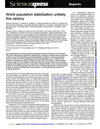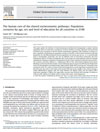-
New Approaches to Projecting Population Yield Divergent Forecasts and Valuable Insights
October 1, 2014 By Sarah Meyerhoff As the UN General Assembly begins charting a course toward sustainable growth, population projections will likely undergird many of their most important assumptions about the future. As two new papers released last week demonstrate, however, there are differing opinions about how much the world’s population will grow and when it will stabilize.
As the UN General Assembly begins charting a course toward sustainable growth, population projections will likely undergird many of their most important assumptions about the future. As two new papers released last week demonstrate, however, there are differing opinions about how much the world’s population will grow and when it will stabilize. In a study published in Science that made headlines, Patrick Gerland from the UN Population Division, Adrian Raferty from the University of Washington, and others found “there is an 80 percent probability that world population, now 7.2 billion, will increase to between 9.6 and 12.3 billion in 2100.” The study is notable not only for its results, but also for how they were reached. Traditionally, the authors explain, the UN Population Division, which many of the authors work for or used to work for, uses country-level data on age and sex, as well as fertility, mortality, and migration rates combined with a probabilistic Bayesian model of the future to project overall global population growth. It presents this projection, called the medium variant, alongside high and low variant scenarios, calculated by raising or lowering expected fertility rates by 0.5. In this study, however, the authors used the Bayesian model for the high and low variants as well, creating a fully probabilistic range. This model, the authors say, better incorporates unexpected trends (like slower than expected declines in African fertility rates) and provides increased sophistication and accuracy. For example, they say, in 2001 demographer Wolfgang Lutz “gave an 85 percent probability that world population growth would end in the 21st century, but our probabilistic projection indicates that this probability is much lower, at only 30 percent.”
In a study published in Science that made headlines, Patrick Gerland from the UN Population Division, Adrian Raferty from the University of Washington, and others found “there is an 80 percent probability that world population, now 7.2 billion, will increase to between 9.6 and 12.3 billion in 2100.” The study is notable not only for its results, but also for how they were reached. Traditionally, the authors explain, the UN Population Division, which many of the authors work for or used to work for, uses country-level data on age and sex, as well as fertility, mortality, and migration rates combined with a probabilistic Bayesian model of the future to project overall global population growth. It presents this projection, called the medium variant, alongside high and low variant scenarios, calculated by raising or lowering expected fertility rates by 0.5. In this study, however, the authors used the Bayesian model for the high and low variants as well, creating a fully probabilistic range. This model, the authors say, better incorporates unexpected trends (like slower than expected declines in African fertility rates) and provides increased sophistication and accuracy. For example, they say, in 2001 demographer Wolfgang Lutz “gave an 85 percent probability that world population growth would end in the 21st century, but our probabilistic projection indicates that this probability is much lower, at only 30 percent.” Lutz and several of his colleagues at Wittgenstein Centre for Demography and Global Human Capital updated their own projections earlier this summer. Through a peer review-style inquiry of over 500 experts, the authors calculated a medium variant future scenario similar to ones they predicted previously: a continued population rise to 9.2 billion in 2050, followed by a peaking around 9.4 billion in the 2070s and a decline to 9 billion by 2100. But their methods of projection are new: they include not one future scenario, but five. In these shared socio-economic pathways, different prevailing forces (including inequality, instability, sustainable development, and technological innovation) shape demographic factors in OECD and high- and low-fertility countries, as well as societal capacities to deal with climate change. However, the study is also innovative in that it includes education, alongside fertility, mortality, and migration rates, and age and sex distributions as a major demographic factor. The authors point out that increased education – and particularly the educational attainment of young women – has been demonstrated not only to lower fertility and mortality, but also improve sustainable development outcomes, with direct effects on food security, democratic transition, and vulnerability to climate-related disasters. By providing country-specific data on educational attainment, the authors hope that their model will “help to address the differential vulnerability of population in the sense that it not only matters where you are but also who you are in terms of your capabilities and adaptive capacity.”
Lutz and several of his colleagues at Wittgenstein Centre for Demography and Global Human Capital updated their own projections earlier this summer. Through a peer review-style inquiry of over 500 experts, the authors calculated a medium variant future scenario similar to ones they predicted previously: a continued population rise to 9.2 billion in 2050, followed by a peaking around 9.4 billion in the 2070s and a decline to 9 billion by 2100. But their methods of projection are new: they include not one future scenario, but five. In these shared socio-economic pathways, different prevailing forces (including inequality, instability, sustainable development, and technological innovation) shape demographic factors in OECD and high- and low-fertility countries, as well as societal capacities to deal with climate change. However, the study is also innovative in that it includes education, alongside fertility, mortality, and migration rates, and age and sex distributions as a major demographic factor. The authors point out that increased education – and particularly the educational attainment of young women – has been demonstrated not only to lower fertility and mortality, but also improve sustainable development outcomes, with direct effects on food security, democratic transition, and vulnerability to climate-related disasters. By providing country-specific data on educational attainment, the authors hope that their model will “help to address the differential vulnerability of population in the sense that it not only matters where you are but also who you are in terms of your capabilities and adaptive capacity.”Sources: Global Environmental Change, Science.
 A Publication of the Stimson Center.
A Publication of the Stimson Center.





